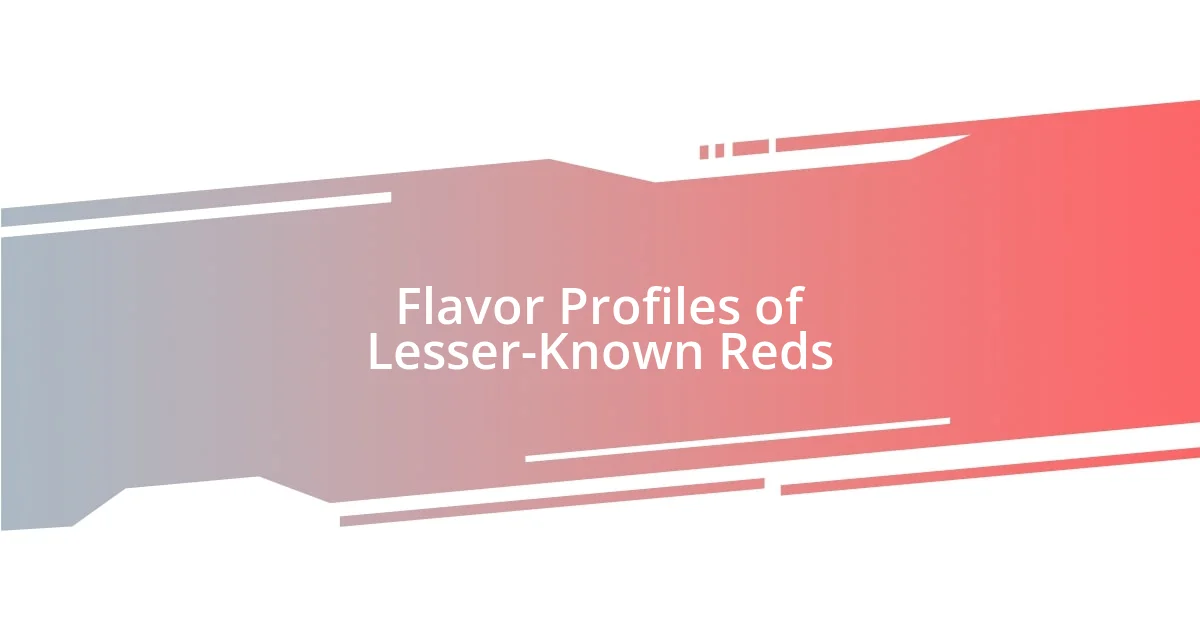Key takeaways:
- Exploring lesser-known red wines reveals diverse flavors and enriches wine appreciation through unique stories behind each varietal.
- Food pairings with these wines can elevate ordinary meals, enhancing the overall dining experience and creating memorable moments.
- Engaging with wine communities and sharing narratives around lesser-known reds fosters deeper connections and enjoyable social interactions.

Introduction to Lesser-Known Reds
When I first ventured into the world of wines, I found myself gravitating towards familiar labels like Cabernet Sauvignon and Merlot. However, I quickly discovered the captivating realm of lesser-known reds, and it felt like uncovering a hidden treasure. What struck me was the diversity in flavors and stories behind these wines that often go unnoticed.
I vividly remember my first encounter with a Tannat from Uruguay. It was a delightful surprise, bursting with rich berries and a hint of earthiness that awakened my palate. This experience made me wonder—could there be a treasure trove of flavors waiting in lesser-known varietals? Exploring these wines has since become a passion of mine, as each bottle reveals unique characteristics and histories that enrich my appreciation for wine.
There’s something truly exhilarating about sharing a bottle of lesser-known red with friends. The conversations that spark from a unique wine choice are always lively, almost like a secret club. What if you could be the one to introduce your friends to a whole new world of taste? In my experience, these wines can make ordinary moments feel extraordinary, turning a simple dinner into a memorable occasion.

Flavor Profiles of Lesser-Known Reds
The flavor profiles of lesser-known reds can be incredibly diverse, pulling you into a rich tapestry of tastes and aromas. Take, for example, the intriguing Monastrell from Spain; its flavor can evoke memories of sun-drenched vineyards with a captivating blend of dark fruits and a smoky finish. I vividly recall enjoying a bottle of Cinsault during a picnic, where its bright acidity complemented the fresh cheese and charcuterie we had laid out. The wine felt like a dance of strawberries and herbs, refreshing yet complex, and it made me appreciate how lesser-known varietals can elevate an experience.
Here’s a snapshot of some fascinating flavor profiles found in lesser-known reds:
- Tannat: Bold and tannic with layers of blackberry, cocoa, and earthy notes.
- Carignan: Known for its vibrant acidity, offering flavors of red cherries, plum, and a hint of spice.
- Cinsault: Light and aromatic, presenting juicy red fruit flavors balanced with herbal undertones.
- Nero d’Avola: Rich and full-bodied with ripe black fruit, floral notes, and a touch of licorice.
- Bobal: Surprising weights of dark berries and a slight rustic quality, making it genuinely unique.
Each of these wines tells a distinct story, often inviting you to savor moments that linger long after the last sip.

Food Pairings for Unique Reds
When it comes to finding perfect food pairings for unique reds, I’ve explored some surprising combinations that really enhance the experience. For instance, I once paired a bottle of Tannat with a hearty beef stew. The wine’s bold tannins embraced the richness of the meat, while its back notes of blackberry and cocoa highlighted the spices in the dish. It’s amazing how a lesser-known red can complement a familiar meal in such an extraordinary way.
Another memorable pairing I stumbled upon was with Monastrell and a Mediterranean platter featuring olives, hummus, and grilled vegetables. The wine’s deep fruit flavors and smokiness danced harmoniously with the brininess of the olives and the creaminess of the hummus. This combination reminded me that wines often thought of as obscure can elevate a simple gathering into a culinary adventure.
If you’re looking for straightforward guidelines, creating your own pairings can be rewarding and fun. Here are some comparisons to consider as you explore food and wine pairings for lesser-known reds:
| Wine Type | Food Pairing |
|---|---|
| Tannat | Hearty beef stew |
| Monastrell | Mediterranean platter |
| Cinsault | Grilled chicken with herbs |
| Nero d’Avola | Rich tomato sauce pasta |
| Bobal | BBQ ribs or smoked meats |

Regions Producing Hidden Gems
When I think of regions producing hidden gems, the rugged terrains of southern France often come to mind. One of my favorite discoveries was a bottle of Picpoul de Pinet, produced near the Thau Lagoon. Its crispness matched perfectly with the fresh oysters I was enjoying, and I couldn’t help but marvel at how this lesser-known wine elevated such a simple dish into a luxurious experience. Have you ever found a wine that completely transformed your view of the food on your plate?
Another unexpected delight comes from the valleys of Uruguay, where Tannat reigns supreme. I recently tasted an exceptional example that was rich and velvety, with a depth of color that seemed to capture the essence of the region. As I sipped this velvety wine, surrounded by friends at a lively barbecue, I realized how these lesser-explored areas can produce reds that rival their more famous counterparts. What surprises might you uncover if you explore beyond the usually recommended regions?
Then there’s the impressive potential of Greece’s Naoussa region with its Xinomavro varietal. I stumbled upon a bottle during a small wine tasting event and was utterly captivated by its robust character and intense notes of dark cherry. The wine seemed to resonate with the lively discussions we were having, making me appreciate how the cultural richness of a region can complement the wines produced there. Could it be that each glass holds a story waiting to be shared?

Tips for Exploring Lesser-Known Reds
When diving into lesser-known reds, I can’t recommend visiting local wine shops enough. I love asking the staff about their favorite hidden gems; their passion often leads me to exquisite bottles I wouldn’t have discovered on my own. Have you ever felt that thrill when you find a wine that perfectly suits your palate after a lively conversation with someone who shares your enthusiasm?
Another tip is to attend tastings or join a wine club focused on unique varietals. I once joined a small group that specialized in international wines, where we explored bottles like Zweigelt from Austria and Agiorgitiko from Greece. Each meeting felt like an adventure, letting me explore new flavors and stories behind each wine—the camaraderie made every sip even more delightful.
Lastly, don’t shy away from experimenting with different varietals during casual gatherings. I vividly recall hosting a dinner party where I blind-tasted my friends on a bottle of Cinsault. Watching their expressions change with each sip, as they guessed the origins and flavors, was extraordinary. It reminded me that exploring lesser-known reds can be a communal experience, turning every bottle into a new memory shared among friends. What unexpected discoveries might you make with each exploration?

Recommendations for Enjoying these Wines
For a truly immersive experience with lesser-known reds, I recommend pairing them with dishes that compliment their unique flavor profiles. One magical evening, I served a light-bodied Pinotage alongside grilled salmon, and the way the smoky flavors of the fish enhanced the wine was nothing short of enchanting. Have you ever noticed how a perfect pairing can make you appreciate both the food and the wine so much more?
Exploring lesser-known reds is also about storytelling, so I suggest you share those stories with your guests. During a recent dinner, I presented a bottle of Baga from Portugal, and as I recounted the winemaker’s commitment to sustainable practices, it sparked vibrant discussions at the table. I found that when you engage others in a narrative, it not only enriches the tasting experience but also creates a deeper connection between the wine and the people enjoying it.
Lastly, consider hosting a themed tasting night that focuses solely on these hidden gems. I organized a “Global Reds” evening featuring varietals like Blaufränkisch and Saint-Laurent, and the diversity was truly eye-opening. Each bottle led to animated exchanges about the regions and grapes, sparking an excitement that lingered long after the last sip. What if your next gathering could turn into a journey around the world through your wine glasses?

Conclusion on Lesser-Known Reds
Lesser-known reds have a way of transforming the wine experience into something profoundly unique. I fondly remember my first encounter with a bottle of Primitivo from Puglia; the ripe fruitiness wrapped around hints of spice completely took me by surprise. It made me realize that exploring these hidden varietals can ignite a deeper appreciation for wine, as each pour tells a story that’s waiting to unfold.
In my journey, I’ve often found that sharing these lesser-known reds leads to meaningful conversations and connections. I recall a lively evening where I introduced a bottle of Counoise to my friends, and as we savored its nuances, we were all drawn into discussions about our travels and the adventures associated with food and wine. Isn’t it fascinating how a single bottle can bridge gaps and create a shared experience that enhances our relationships?
Ultimately, embracing lesser-known reds not only broadens our palates but also enriches our social interactions and personal narratives. Each tasting becomes a memory, each bottle a chapter in my wine journey. What treasures might you discover in these overlooked varietals that could beautifully flavor your own experiences?















